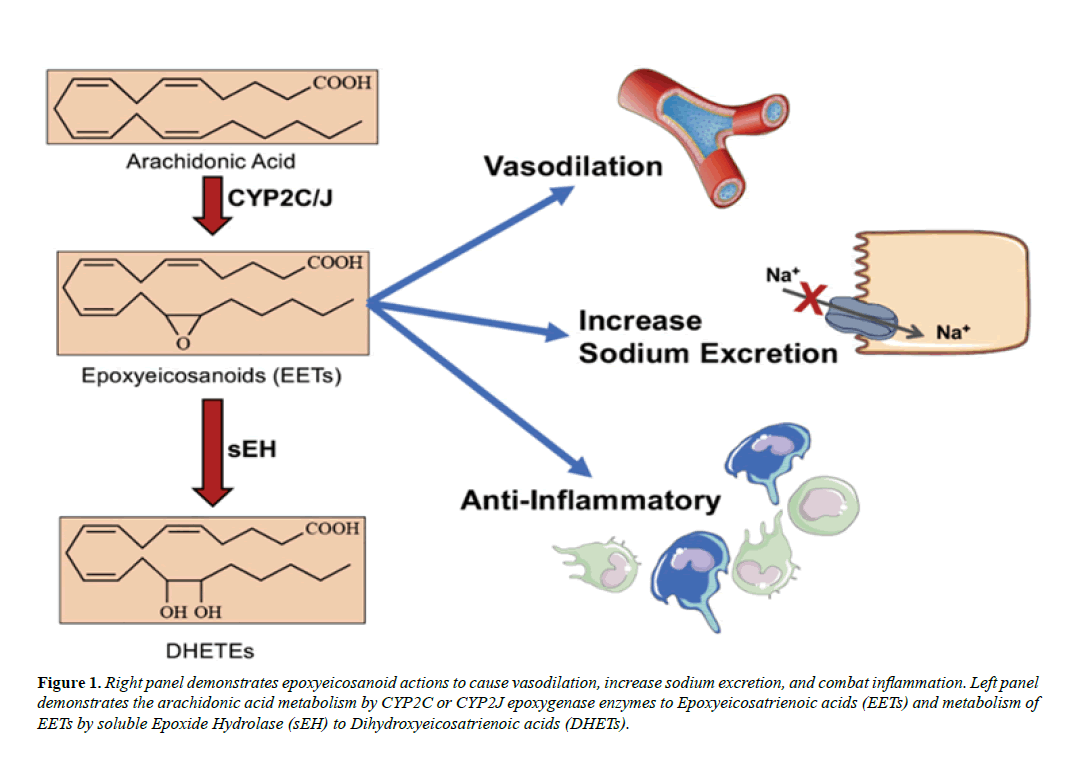Image Article - Annals of Cardiovascular and Thoracic Surgery (2020) Volume 3, Issue 3
Epoxyeicosanoids Role in Hypertension
Hazel Green*
Allied Academies, 40 Bloomsbury Way, Lower Ground Floor, London, United Kingdom
- *Corresponding Author:
- Hazel Green
Allied Academies
London, United Kingdom
E-mail: info@alliedacademies.org
Accepted: September 29, 2020
Abstract
Epoxyeicosatrienoic acids (EETs) are 20 carbon epoxy fatty acids also known as epoxyeicosanoids. EETs are generated from arachidonic acid by cytochrome (CYP) P450 epoxygenases. Epoxyeicosatrienoic acids (EETs) have cardiovascular and renal actions and these actions can be regulated by soluble Epoxide Hydrolase (SEH) that degrades and inactivates EETs have reduced or no biological activity. Epoxyeicosanoids have natriuretic, vasodilator and anti-inflammatory activities lower blood pressure and also decrease the cardiovascular and renal disease progression. EETs are produced and have activities in endothelial kidney, heart, cells and other organs that impact blood pressure regulation. Blood pressure regulating EET actions include vasodilation, increasing sodium excretion, and decreasing inflammation. CYP2C epoxygenase enzyme gene variants demonstrate increased risk for essential hypertension and reduced EET generation.Description
Epoxyeicosatrienoic acids (EETs) are 20 carbon epoxy fatty acids also known as epoxyeicosanoids. EETs are generated from arachidonic acid by cytochrome (CYP) P450 epoxygenases. Epoxyeicosatrienoic acids (EETs) have cardiovascular and renal actions and these actions can be regulated by soluble Epoxide Hydrolase (SEH) that degrades and inactivates EETs have reduced or no biological activity. Epoxyeicosanoids have natriuretic, vasodilator and anti-inflammatory activities lower blood pressure and also decrease the cardiovascular and renal disease progression. EETs are produced and have activities in endothelial kidney, heart, cells and other organs that impact blood pressure regulation. Blood pressure regulating EET actions include vasodilation, increasing sodium excretion, and decreasing inflammation. CYP2C epoxygenase enzyme gene variants demonstrate increased risk for essential hypertension and reduced EET generation. Appealingly, increase in EET levels hypertension animal models results in blood pressure lowering and cardiovascular protective actions. These compelling outcomes support the concept that increasing epoxyeicosanoids via EET analogs or sEH inhibitors could be a valuable treatment for hypertension.
Figure 1: Right panel demonstrates epoxyeicosanoid actions to cause vasodilation, increase sodium excretion, and combat inflammation. Left panel demonstrates the arachidonic acid metabolism by CYP2C or CYP2J epoxygenase enzymes to Epoxyeicosatrienoic acids (EETs) and metabolism of EETs by soluble Epoxide Hydrolase (sEH) to Dihydroxyeicosatrienoic acids (DHETs).
